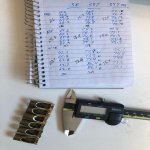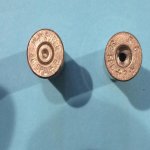- Location
- Saskatchewan
I have a bunch of Lyman cast bullets that are designed to fit .38 special brass when seated to the lower crimp groove, so they are at .357 magnum length. "#358156, 158 grain gas check" I believe. I have data that shows loading them with the same charges as .357 magnum. I've loaded and shot quite a few with no issues.
So that got me wondering. I have a lot of .38 special cases, not many .357 mag cases, and another bullet on hand that has two crimp grooves. The Hornady 180gr. fp/sil. Does anyone have experience or data crimping this one in the lower crimp groove when loaded in .38 special cases and using .357 mag data?
As far as I can see, the construction of .38 special brass is identical in case head thickness to .357 magnum. Or is this incorrect? Depend on brand? It would seem to me that the 1/10" case length is irrelevant if the interior volume/over all length & seating depth is the same.
I'd be shooting these in two strong rifles, not a revolver. Miroku manufactured Win M92 .357 mag and a Ruger M77/357. The Winchester won't reliably feed shorter cartridges.
What do you say?
So that got me wondering. I have a lot of .38 special cases, not many .357 mag cases, and another bullet on hand that has two crimp grooves. The Hornady 180gr. fp/sil. Does anyone have experience or data crimping this one in the lower crimp groove when loaded in .38 special cases and using .357 mag data?
As far as I can see, the construction of .38 special brass is identical in case head thickness to .357 magnum. Or is this incorrect? Depend on brand? It would seem to me that the 1/10" case length is irrelevant if the interior volume/over all length & seating depth is the same.
I'd be shooting these in two strong rifles, not a revolver. Miroku manufactured Win M92 .357 mag and a Ruger M77/357. The Winchester won't reliably feed shorter cartridges.
What do you say?











































































